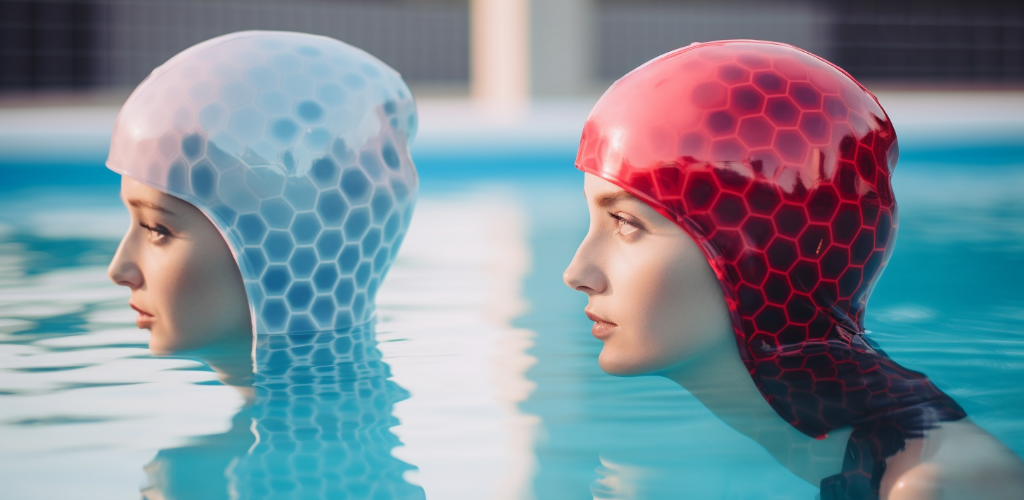Have you ever wondered why swimmers always seem to wear those sleek swim caps? Or have you found yourself in the swim accessories aisle, confused between silicone and latex swim caps? If so, you’re not alone. Swim caps are an essential part of water sports, but choosing the right one can feel like a daunting task. This blog post aims to compare silicone and latex swim caps, helping you decide which one might be the best fit for your swimming needs.
Let’s dive right in!
The Importance of Swim Caps in Water Sports
Swim caps aren’t just a fashion statement in the pool. They play a vital role in water sports, providing numerous benefits. Swim caps protect your hair from damaging chlorine and saltwater. Ever noticed how swimmers glide effortlessly through the water? That’s partly thanks to swim caps, which reduce drag and increase speed. Plus, they promote good hygiene by preventing loose hair from floating in the pool. Now that’s what we call a triple threat!
Understanding the Basic Materials: Silicone and Latex
Before we dive into the specifics, let’s get to know the two popular materials used in swim caps: silicone and latex. Silicone is a synthetic material known for its durability and elasticity. It’s smooth, non-porous, and resistant to heat and cold. On the other hand, latex is a natural rubber with a reputation for flexibility and resilience. It’s thinner, lighter, and more breathable than silicone. But which one takes the crown in the world of swim caps? Let’s find out!
Characteristics of Silicone Swim Caps
Ever wondered why silicone swim caps are so popular among swimmers? Well, it’s all due to their distinct features. Silicone swim caps are renowned for their durability, comfort, and elasticity. But what does this mean for you as a swimmer?
With their durability, silicone caps can withstand regular use without tearing or wearing out. Think of it as an investment that keeps on giving. Their comfort aspect is another big plus. Silicone caps are generally thicker and softer, providing a comfortable fit that’s perfect for long swimming sessions. Remember those annoying forehead marks after swimming? With silicone caps, it’s a thing of the past! Lastly, let’s talk about elasticity. Silicone caps stretch easily to accommodate various head sizes without feeling too tight. So, whether you have a small head or a big one, a silicone cap has got you covered!
Pros of Silicone Swim Caps
So, what makes silicone swim caps a favorite for many swimmers? Let’s break it down:
- Durability: Silicone swim caps last longer. They are tear-resistant and can withstand frequent use, making them perfect for regular swimmers.
- Comfort: With their thicker and softer texture, silicone swim caps provide a comfortable fit that won’t leave you with forehead marks.
- Elasticity: Silicone swim caps can stretch easily to accommodate various head sizes without feeling too tight.
- Protection: Silicone swim caps offer excellent protection for your hair from chlorine and saltwater.
Cons of Silicone Swim Caps
Despite their great features, silicone swim caps also have their downsides. Here’s what you need to know:
- Price: Compared to latex swim caps, silicone ones come with a higher price tag. This could be a deciding factor for swimmers on a budget.
- Slipping: Due to their smooth texture, silicone swim caps can sometimes slip off, especially if you have long hair.
- Heat retention: Silicone swim caps retain more heat, which might not be ideal for swimmers who get easily overheated.
Remember, no swim cap is perfect. Whether silicone swim caps are the right choice for you will depend on your specific needs and preferences. Weigh the pros against the cons and make an informed decision.
Features of Latex Swim Caps
Have you ever wondered what makes latex swim caps a popular choice among swimmers? Well, it’s not just about their affordability! One of the more notable characteristics of latex swim caps is their thinness. This makes them feel almost like a second skin, providing a snug fit that’s comfortable to wear. Due to their thin nature, they also offer a high level of breathability which can be a huge plus, especially during those long swimming sessions.
Another standout feature is their cost. Compared to silicone swim caps, latex swim caps tend to be more affordable, making them a great option for those on a budget. Now, that doesn’t mean they compromise on performance – far from it. Latex swim caps continue to deliver on the promise of improving your swimming speed and protecting your hair from chlorine and other pool chemicals.
Benefits of Latex Swim Caps
Now that we know a bit more about the features of latex swim caps, let’s dive into the benefits. The first thing to mention is their affordability. As we’ve already touched on, latex swim caps are typically cheaper than their silicone counterparts. This makes them a go-to choice for people who swim occasionally or are just starting out.
They’re also incredibly lightweight. The thinness of latex swim caps not only ensures breathability but also makes them light as a feather. This, in turn, enhances the overall comfort, making your swimming experience a lot more enjoyable. And who doesn’t want that?
Drawbacks of Latex Swim Caps
Just like anything else, latex swim caps come with their own set of drawbacks. One of the main issues is their durability. These swim caps tend to tear more easily compared to silicone ones. This is largely due to their thin nature, which while providing comfort and breathability, also makes them less resistant to wear and tear.
Another potential downside to consider is allergies. Some people may have a latex allergy, which could cause reactions ranging from minor skin irritation to more serious symptoms. If you’re allergic to latex, it’s best to steer clear of these types of swim caps and opt for silicone ones instead.
Silicone vs Latex: A Comparative Analysis
Now, let’s get down to the nitty-gritty, shall we? It’s time for a head-to-head comparison between silicone and latex swim caps. We’ve talked about each of their unique characteristics, advantages, and disadvantages. But how do they stack up against each other when we put them side by side?
Let’s break it down in a way that’s easy to digest. Here’s a table that will give you a clear picture of the silicone vs latex showdown.
| Feature | Silicone Swim Caps | Latex Swim Caps |
|---|---|---|
| Durability | High | Low |
| Comfort | High | Medium |
| Elasticity | High | High |
| Price | High | Low |
| Allergy Risk | Low | High |
Factors to Consider When Choosing a Swim Cap
With all this information, you might be wondering, “How do I choose the right swim cap for me?” Well, that’s a great question! There are several personal factors that can influence your decision. Let’s dive into some of these.
Budget: Silicone swim caps tend to be pricier than their latex counterparts. If you’re on a tight budget, a latex cap might be the more economical choice.
Frequency of use: If you’re an avid swimmer and hit the pool frequently, investing in a durable silicone cap might be a wise decision.
Comfort: Some swimmers find silicone caps more comfortable due to their smooth and stretchy nature. However, comfort can be subjective, so it’s essential to try on both types and see what feels best for you.
Allergies: Latex allergies are quite common. If you have a known allergy or sensitivity to latex, it’s best to stick to a silicone swim cap.
Making the Best Choice for Your Swimming Needs
At the end of the day, the best choice for a swim cap is entirely dependent on your individual needs and preferences. There’s no one-size-fits-all answer.
Remember, it’s not about which cap is objectively better. It’s about which cap is better for you. Whether you lean towards silicone or latex, the most important thing is that you’re comfortable and can swim with ease.
Take the time to consider all the information we’ve discussed here. Weigh the pros and cons, and make a decision that aligns with your swimming goals, personal comfort, and budget. Happy swimming!




